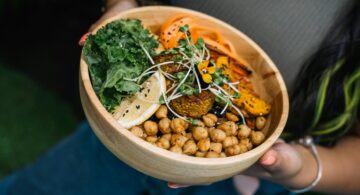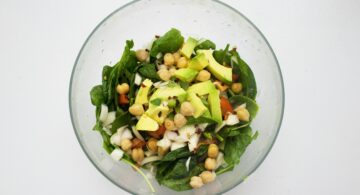Why Everyone Should Eat More Avocados
They’re creamy, they’re fatty, and the best part: they’re good for you.
Avocados are a naturally nutrient-dense food and contain nearly 20 vitamins and minerals. They are a great source of vitamins C, E, K, and B-6, as well as riboflavin, niacin, folate, pantothenic acid, magnesium and potassium. They also provide lutein, beta-carotene and omega-3 fatty acids. Avocados can act as a “nutrient booster” by helping increase the absorption of fat-soluble nutrients like Vitamins A, D, K and E.
Health professionals have known for a long time that avocados fit within a balanced diet, but their naturally high fat content may have you wondering whether they are in fact healthy.
Luckily, that high fat content, along with a variety of other attributes, make avocados a great food to consume regularly. Here’s the proof that you need, along with a few fun recipes, to buy a few avocados on your next trip to the grocery store.
Types of Avocados
Avocados come in many shapes and sizes, the most common of which is the Hass.
Different varieties are best for different uses:
- Hass is a creamy, nutty-flavored avocado that has become the standard by which most Americans now judge avocados.
- Gwen is slightly larger than the Hass, but shares many of the same texture and taste qualities. However, it has a slightly smoky flavor, somewhat akin to that of chipotle chiles. It has a silky flesh and is delicious on its own or spread on bread like butter.
- The Pinkerton has a longer, thinner “neck” and high oil content. It also has a richer, fuller flavor than the Hass. Unlike a Hass avocado, the Pinkerton skin does not turn black when ripe!
- The Reed has firmer flesh, making it better for cutting. Its flesh has a good quality with a nutty taste. All you need is a sprinkle of sea salt and a spoon to scoop out its creamy goodness.
The Benefits of Avocado
These days, the avocado has become an incredibly popular food among health conscious individuals. It is often referred to as a superfood… which is not surprising given its health properties.
1. High Fat Content
Yes, this is a benefit. Fat is necessary for the body. Fat helps protect organs, keep your body warm, increase energy, and support cell growth. In fact, fat provides more ATP (energy) for your body than proteins or carbohydrates.
In fact, 75%-80% of the calories in avocados come from fat. The bulk of these fats are healthy and what your body needs more of. More than two-thirds of the fats found in avocados are monounsaturated. Monounsaturated fat helps reduce LDL (bad) cholesterol in your blood, reducing your risk of heart disease and stroke. Fear not the fat in avocados!
2. Naturally Sodium and Cholesterol Free
It seems as though these two things—sodium and cholesterol—are a constant topic of conversation in the health world, and for good reason: high levels of sodium can be found in even the healthiest foods, like nut butter or pre-made soup. But avocados are sodium-free.
Avocados contain cholesterol-smashing beta-sitosterol that reduces the amount of cholesterol absorbed from food. The combination of beta-sitosterol and monounsaturated fat makes the avocado an excellent cholesterol buster.
Swap your peanut butter for avocado on your toast one day a week to reduce sodium intake. Top your toast with tomato slices or salt and pepper for a bigger flavor punch and even more healthy nutrients.
3. High Potassium Levels
Potassium is a crucial nutrient, playing key roles in muscle strength, nerve function and heart health. And if you don’t get enough—4,700 mg a day—it could lead to a deficiency, complete with fatigue, muscle cramps, heart palpitations and dizzy spells.
The banana has been king of potassium for a long time, but not anymore. A single avocado has 975 milligrams of potassium, while a large banana offers 487 milligrams. Even if you only eat half an avocado, you’re still getting the equivalent potassium of a whole banana. Avocados offer a good way to give your body a different, and significant, source of potassium.
4. High Protein Levels
Avocados are technically a fruit. But as such, they have the highest protein content of any fruit—4 grams. In comparison to chicken or fish, this may be a small amount of protein per serving. But avocados provide all 18 essential amino acids necessary for the body form a complete protein. Unlike the protein in steak, which is difficult to digest, the body readily absorbs avocado protein because it contains fiber.
Protein is a critical macronutrient for repairing muscles and helping you focus, among other things. Thus, getting a little protein with every meal and snack is important. For a protein-packed breakfast, make a smoothie made from avocado, blueberries and sunflower seeds.
As with anything, it’s important to eat avocados in moderation. While they have a variety of amazing health benefits, they are high in calories. Stick with a 1/2-avocado serving size to reap the benefits without loading on the calories.
It’s time to start thinking of avocados as a regular diet supplement. Get them into your daily diet in salads, on sandwiches or just plain guacamole. Here are a few ways you can get more avocados in your diet.
Deconstructed Guacamole
Serves 5-10 peopleIngredients:
- 5 small avocados
- 2 medium-sized roma tomatoes, chopped small
- 1 red onion, chopped small
- 1 tablespoon cumin
- 1 teaspoon salt
- 1 teaspoon pepper
- 1/2 cup black beans
- 1/4 cup cilantro
- 1 teaspoon lime juice (add more as needed)
Directions:
- Cut all avocados in half and remove seed.
- In a medium-sized bowl, gently mix all other ingredients together.
- Situate avocados on a tray, and fill seed holes with the tomato mixture.
Creamy Asparagus Soup
Serves 2-4 people
Adapted from CookEatPaleo.com.
Ingredients:- 6 large bunches of asparagus
- 1 tablespoon olive oil
- 2 garlic cloves, minced
- 2 cups broth (chicken, vegetable)
- 1 medium-ripe avocado, cubed
- 3 tablespoons lemon juice
- Salt and pepper to taste
Directions:
- Prep asparagus, toss with olive oil, salt, pepper and minced garlic, and place on a sheet pan.
- Roast at 400 degrees for 10-15 minutes.
- Blend finished asparagus with the rest of the ingredients in a food processor until smooth.
- Add water or more broth if needed, and heat over stove before serving.
Farro Salad With Avocado Dressing
Serves 1
Farro salad ingredients:- 1 cup farro
- 3 cups broth or water
- 1 teaspoon salt, pepper, cumin
- 3 cups kale, ripped into large pieces
- 1 tablespoon olive oil
- 1 cup grape tomatoes, sliced in half
- 1/2 cup chickpeas
Dressing ingredients:
- 1/4 medium avocado
- 1/4 cup balsamic vinegar
- 1/3 cup olive oil
- 1/2 teaspoon salt
- 1/2 teaspoon pepper
- 1/2 teaspoon garlic powder
Directions:
- Add raw farro to 3 cups water or broth adding half the salt and pepper, and all of the cumin. Cook uncovered, over medium heat for 30 minutes.
- While that cooks, add kale to a sauté pan, toss with olive oil and the rest of the salt and pepper, cooking until kale leaves have wilted.
- Add the tomatoes and chickpeas. Remove when tomatoes have blistered slightly.
- Put all dressing ingredients into a food process and blend until smooth.
- Add 1 cup of cooked farro to a bowl or plate, top with the kale mixture, and drizzle with the creamy dressing.
Avocado is not only good for you, but has seemingly endless applications in the kitchen. Try a few of these recipes and experiment to see where avocados fit into your daily diet. With extra protein, healthy fat and plenty of potassium, you’ll love these little creamy treasures of nature.
If you like this article, then you’ll love these:



























